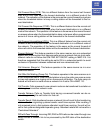
Do Not Disturb (DND). This feature operates in the same manner as in a non net-
worked switch. There is an option in MMC 823 to determine the type of DND tone
sent across the network link.
Caller ID. Caller ID in its various forms that are currently available (Analog CID Name
and Number, ANI Number, PRI Name and Number and BRI number) will be trans-
ported across the network link with the original call.
Centralized Attendant. This feature basically allows a user in any switch to dial “0”
and ring at the designated Central attendant group. Each system on the network
requires its own designated attendant group for local usage, recalls and the like.
Intercom Calling/Uniform Dialing Plan. Station to station and station to group calls
can be made across the network link without having to dial an access code for a
call within the network. LCR can also be programmed to route calls across a net-
work link to access local trunks in another networked system.
Centralized Voice Mail with Message Waiting Lights. This feature will only operate
with SVMi voicemail systems only. Users in one node can call forward (CFNR, CFB
& CFU) to the SVMi group in a different switch and messages left in that switch will
be indicated on the VMSG key in the origination switch. Messages can be returned
to the voice mail group by pressing the VMSG key.
OFF PREMISES EXTENSIONS (OPX)
A single line (tip and ring) extension from an SLI card may be connected to tele-
phone company-provided OPX circuits to remote locations. 8SLI cards and KDb-
SLIs do not support off premises extensions.
OPERATOR GROUP
The operator group can contain 32 stations to answer incoming calls. Calls to this
group can be set for distributed, sequential or unconditional ringing. Operators
can use the In/Out of Group feature to meet flexible operator requirements. Opera-
tor groups are selectable per ring plan.
OVERFLOW
OPERATOR
When calls ringing a operator group go unanswered, they can overflow to another
destination after a programmed period of time. The operator group has its own
timer. The overflow destination can be a station or station group.
STATION GROUP
When calls ringing a station group go unanswered, they can overflow to another
destination after a programmed period of time. Each station group has its own
timer. The overflow destination can be a station or station group.
4.22
HOME
PAGE
Table of
Contents


















